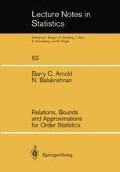Abstract
In the last chapter we have discussed some universal bounds for the moments of order statistics. In this chapter we shall develop some methods of approximating these moments of order statistics from an arbitrary continuous distribution. First of all, we study the order statistics from a uniform distribution in detail in Section 1 and derive exact and explicit expressions for the single and the product moments. Then, as first noted by K. Pearson and M.V. Pearson (1931) and later worked out in great detail by David and Johnson (1954), these moments of uniform order statistics may be used to develop some simple series approximations for the moments of order statistics from a continuous distribution. (This is to be expected after all in view of the result that the probability integral transformation U = F(x) transforms the order statistic Xi:n from any continuous distribution into the order statistic Ui:n from a uniform U(0,1) distribution (see Chapter 1).) These series approximations are presented in Section 2. Some similar series expansions have been developed for the first and second order moments of order statistics by Clark and Williams (1958) and these are discussed in Section 3. A different kind of series approximation based on the logistic distribution rather than on the uniform distribution, due to Plackett (1958), is presented in Section 4. In Section 5, we discuss the findings of Saw (1960) who has employed the Darboux form for the remainder in a Taylor series expansion in order to obtain bounds for the remainder term when the expansion for the first single moment μi:n (1 ≤ i ≤ n) is terminated after an even number of terms in the series. A very interesting and somewhat involved method based on orthogonal inverse expansion which gives approximations as well as bounds for the single and the product moments of order statistics has been developed by Sugiura (1962,1964). This method of approximation is discussed in great detail in Section 6. Sugiura’s method, however, requires that the population have a finite variance. In Section 7, we present a generalization due to Joshi (1969) which provides similar bounds and approximations with less stringent conditions.
Access this chapter
Tax calculation will be finalised at checkout
Purchases are for personal use only
Preview
Unable to display preview. Download preview PDF.
Author information
Authors and Affiliations
Rights and permissions
Copyright information
© 1989 Springer-Verlag Berlin Heidelberg
About this chapter
Cite this chapter
Arnold, B.C., Balakrishnan, N. (1989). Approximations to Moments of Order Statistics. In: Relations, Bounds and Approximations for Order Statistics. Lecture Notes in Statistics, vol 53. Springer, New York, NY. https://doi.org/10.1007/978-1-4612-3644-3_4
Download citation
DOI: https://doi.org/10.1007/978-1-4612-3644-3_4
Publisher Name: Springer, New York, NY
Print ISBN: 978-0-387-96975-6
Online ISBN: 978-1-4612-3644-3
eBook Packages: Springer Book Archive

